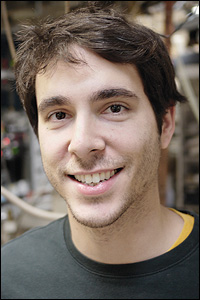News Story
Bartis Wins Wylie Fellowship for Research on Plasma for Disinfection

MSE graduate student Elliot Bartis.
Clark School Department of Materials Science and Engineering (MSE) graduate student Elliot Bartis, co-advised by MSE professors Gottlieb Oehrlein and Joonil Seog, has received a University of Maryland Ann G. Wylie Dissertation Fellowship. The $10,000 award supports students who are in the final stages of completing their Ph.D. studies.
Bartis, who works in the Laboratory for Plasma Processing of Materials, is contributing to the emerging field of “plasma medicine”–in this case referring to ionized gas, not the blood component.
Low-temperature plasma processes have traditionally been used in the production of electronics, and more recently have been applied to the manufacture of nanoscale devices at low pressure. At atmospheric pressure, however, plasma can be used to sterilize surgical equipment and disinfect wounds. Plasma treatments have been found to be effective against bacteria, prions, biomolecules, biofilms, and fungi. Antibiotic-resistant bacteria such as MRSA have no defense against it. Its use in medicine is not widespread, however, because little is known about its antibacterial and antimicrobial properties.
Using controlled conditions and highly sensitive surface characterization techniques, Bartis’ goal is to discover and explain the complex reactions that occur between plasma and biological materials. Bartis is focusing on harmful biomolecules found in the cell walls of several species of bacteria, including E. coli and Staphylococcus aureus, because they are particularly tough.
“They’re more difficult to destroy than bacteria cells when using drugs or traditional cleaning techniques,” Bartis explains. “They can be released into the bloodstream and cause an immune response even if the bacteria have been killed or sterilized.”
In these cases, he says, plasma treatments could supplement antibiotics and the procedures used by hospitals to disinfect surfaces and equipment. “There has even been evidence that plasma treatments cause wounds to heal faster,” Bartis adds, “but no one knows why or how this happens. The technology is still in its infancy.”
Published May 27, 2014









